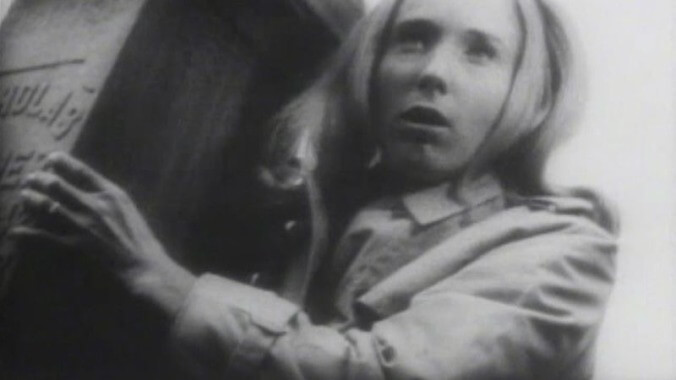Visiting the Night Of The Living Dead cemetery
It takes some effort to get to Evans City Cemetery, a resting place on the outskirts of Evans City, a rural community about 30 miles north of downtown Pittsburgh. For a fan of Night Of The Living Dead making the pilgrimage to the location of its opening scene, that feels appropriate. The George Romero-directed horror classic opens with a sister and brother—Barbra (Judith O’Dea) and Johnny (Russell Streiner)—visiting their father’s grave. Neither seems thrilled with the obligation, but Johnny won’t shut up about it, noting the three-hour drive and how he doesn’t want to “blow Sunday on a scene like this.” In just a couple of lines he sets up the rest of the film, showing how little respect the living have for the dead and what the most extreme consequences of that disrespect would look like, with all the metaphorical possibilities those consequences suggest.
The setting around him does the rest of the work. As cemeteries go, there’s nothing especially creepy about the Evans City Cemetery, as glimpsed in the film, which only makes the attack that follows all the more unsettling. Seemingly alone in the cemetery, Barbra and Johnny spy what appears to be a fellow respects-payer. Johnny adopts a Boris Karloff-like voice to tease Barbra, warning her that the man is actually a ghoul coming to “get” her. Then the taunts come true as Johnny falls victim to the first modern film zombie, a lumbering, flesh-eating, relentless slab of undead humanity. It’s an unthinkable event whose mundane setting lends it extra terror.
Those involved with the film still call the late William Hinzman “Zombie #1” and it’s hard to visit Evans City Cemetery without reflecting on how much has fanned out from that first scene and Hinzman’s performance. Zombies, specifically variations on the zombie that Romero originated, are so ubiquitous that it almost feels as if they’ve always been with us. But this is where they started. If Romero had not filmed the opening so well or if Hinzman had not played his part so convincingly, a whole genre—and all the films, TV shows, books, comics, and videogames that have partaken in it—might never have happened.
A photographer by trade, Hinzman worked alongside George Romero at the commercial and industrial film firm Latent Image, and it was a group of people employed by or in the general circle of Latent Image who formed Image Ten, the production company behind Night Of The Living Dead. Russell Streiner, the hapless Johnny, was among them, as was his younger brother Gary, who served as our host for the cemetery visit. Streiner is officially credited as NOTLD’s sound engineer but, like a lot of the crew, he wore many hats during the shoot. He went on to a peripatetic career after NOTLD, working with Romero for two subsequent films, working in advertising for decades, and then producing the 2002 Jerry Seinfeld documentary Comedian.
Life has brought Streiner full circle, however. He now lives on an Evans City farm he purchased in the early ’70s and spearheads efforts to save the Evans City Cemetery chapel. Glimpsed in the background of Night Of The Living Dead’s opening, it’s an atmospherically dilapidated structure that’s currently a chapel in name only, having been used as a storage shed for decades before being recently marked for demolition. That won’t happen if Streiner and his supporters have their way. He hopes to preserve the structure and help the cemetery at the same time, eventually turning the tiny chapel’s basement space into a museum for fans of the film. He feels so strongly about it, in fact, that he now wears a tattoo, his first, of the chapel on his arm.
His passion is understandable: It’s a part of his history, but part of film history, too. Change doesn’t come fast to a place like Evans City. Its downtown remains recognizable from the role it played in another Romero film, The Crazies, where it served as the location for a different kind of apocalyptic horror film. But when something vanishes, it’s gone for good. The farmhouse that served as NOTLD’s main setting was destroyed not long after the completion of the film (though Streiner did assure us that the land around it remained spooky). And, across town, another Romero landmark may soon face destruction. Streiner urged us to visit the Monroeville Mall, setting of Night’s 1978 sequel Dawn Of The Dead, before its possible demolition. Movies capture the world, sure, but time has a way of making specters out of the most immortal images.
We didn’t make it to Monroeville this time. But maybe that should be the subject of a future Pop Pilgrimage. For now, I’m happy to have had a chance to visit the cemetery where it all began, a peaceful place where the dead rest quietly. But for horror movie fans, the twisty road leading up to it will always be freighted with dread, the chapel will remain a place offering no protection, and that person over the horizon, the one whose gait looks a little off and whose focus a little undirected, might be coming for you, coming to “get” you. Probably not, but in the post-Romero world, it doesn’t hurt to be cautious.
